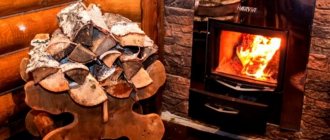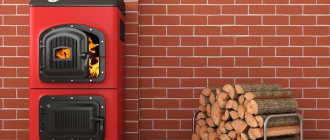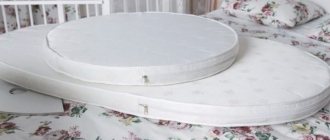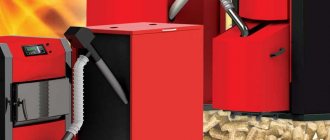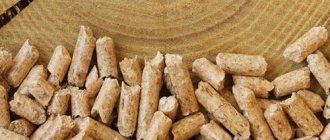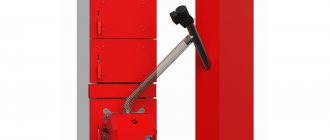Application of pellets
This type of alternative fuel, like straw pellets, is most widely popular in Western countries. In our country, this granular fuel is just beginning to gain popularity.
The methods of using this fuel can be very diverse - these include large, automatic boiler houses in large enterprises, as well as a wide variety of heating processes at the domestic level.
Helpful information. This type of energy carrier has virtually no soot formation processes; units using this fuel should be cleaned no more than once a week.
It is also characteristic that the need for straw pellets is evenly distributed throughout all seasons. Those made from wood waste sell significantly during the cold months. Large power plants generally purchase unlimited quantities according to their volumes.
Straw pellets
Biofuel is fuel made from biological raw materials, such as agricultural waste. There are liquid biofuels (used in various diesel engines, for example, biodiesel and ethanol) and solid biofuels (for example, firewood or straw and fuel pellets from straw, as well as fuel pellets from sunflower husks).
With the rising cost of traditional fuels, the active introduction of various types of alternative fuels has increased, among which pellets have taken the undisputed leadership, gaining a strong place in the global biofuel market.
Fuel or wood pellets are pressed cylinders, with a diameter of 4-10 mm and a length of 2-5 cm, processed from the dry residues of various wastes from the timber processing industry. This is where sawdust, twigs, shavings, bark, branches, etc. come into play. The amount of energy contained in 1 kg. Wood pellets are equivalent to 0.5 liters. Liquid fuel. In addition to economic use, the use of pellets also helps to reduce chemical emissions. Pellets vary in type. Most often, pellets are granules intended for heating various residential buildings. Because of their special inherent whiteness, they are called white. This high-quality type of pellet has a higher cost than pellets for large boiler houses - pellets used in industry are usually several times larger in diameter than their white counterparts. These granules, due to the presence of a high proportion of bark in them, have a grayish color, in contrast to the white granules for heating residential premises. The consumption of pellets for private heating and for industrial systems is a proportion that looks like 1:10. Only a small portion of all wood pellets produced globally is sold through retail chains. Many people wonder where to buy fuel pellets, the answer is that you can do this with us at the lowest prices. Quite often you can find advertisements where to buy fuel pellets in Moscow inexpensively, as well as “I will buy wood pellets,” or something similar. They are still very poorly represented in retail sales, and their prices are greatly inflated. We work directly with the pellet supplier, thanks to which the price for them is very, very low.
The price of pellets for space heating ranges from 140 to 160 euros per ton. They are sold both in bags and in containers specially designated for this purpose. The supply of pellets to the heating boiler rooms of production facilities is carried out automatically. The cost of industrial pellets is approximately 85 euros per ton.
Large pellets are called briquettes. Fuel briquettes are produced using specialized equipment. Presses that simultaneously produce both briquettes and pellets, which are subsequently used in Russia, are also subject to serial production. Wood chip briquettes are typically used in domestic heating systems and come in a variety of sizes and shapes.
The price of briquettes on the European market is sometimes higher than the cost of pellets, but they occupy a significantly smaller market segment of compressed fuels. The production ratio of fuel briquettes and pellets is about 1:20.
Positive properties of pellets
Straw pellets have a number of positive qualities, here are just a few of them:
- are one of the safest types of fuel;
- practically unlimited shelf life, not subject to various rotting processes;
- are environmentally safe (no chemical odors, less carbon monoxide emissions);
- are quite convenient to use;
- in terms of the volume of heat generated they are not inferior to other fuels;
- characterized by a low degree of formation of ash residues;
- fast straw recovery cycle: therefore virtually endless raw materials;
- less expensive compared to other types of fuel.
Helpful information. Pelleted straw can also be used as a replacement for regular straw for bedding.
How to make pellets at home?
In recent years of economic instability, many people perceive the constant rise in prices for gas and electricity as the norm. It is not surprising that private home owners have to think better about how to save money. As a modern and worthy alternative to classic types of fuel, people make pellets with their own hands. This is a biologically pure fuel in the form of granules, which is easily produced at home by processing agricultural or wood waste.
New generation biofuel
Types of fuel pellets
This fuel raw material is made from different types of biomass, which have significant energy value and also allow the material to be crushed and compressed into compact particles. The most popular today is the production of wood pellets, which are made from wood chips, bark, sawdust and other logging and woodworking waste. Vegetable granules are made from husks, sunflower husks, straw, and other crops. Not so popular are peat pellets, as well as pellets made from chicken manure.
Wood pellets are considered the most common
Let's look at the features, production and advantages of wood pellets.
Wood pellets protect the environment
By completely replacing traditional fuel with pellets, the greenhouse effect can be reduced. After all, when fuel burns, carbon dioxide, accumulated over many years, always rises into the air. Wooden elements also emit carbon dioxide, but in minute quantities. After all, they can release the amount of carbon dioxide that has accumulated over the life of the tree and plant.
When using wood pellets, the release of sulfur dioxide is also reduced, which is the main culprit of acid rain, which has a detrimental effect on the environment, destroying entire forests. Now you don’t have to think about accidents at power plants or gas pipelines. The danger of fuel spills, emissions or explosions is reduced to zero.
The granules are environmentally friendly and do not harm the environment
Advantages
In addition to its environmental friendliness, the fuel under discussion has a whole host of significant advantages. The most significant are:
- Good heat transfer compared to boards, chips or regular bark;
- The volume of storage rooms (warehouses) can be reduced by half compared to wood storage rooms;
- Due to the lack of biological activity of materials that have undergone heat treatment, pellets can be placed close to any residential premises;
- You can make pellets with your own hands; they are absolutely not subject to spontaneous combustion, because they do not contain spores or dust. The dense structure also makes them safe for people with allergies;
- During production, various thickeners, adhesives and other chemicals are not added to the particles;
- This type of fuel makes it possible to rationally use any waste;
- Compared to coal, the fuel under discussion makes it possible to obtain the same heat with lower carbon dioxide emissions;
- The price of heating when using the fuel in question is quite reasonable.
Types of wood pellets, their use
Currently, there are two main types of fuel pellets. We are talking about industrial fuel and fuel for private homes. Pellets at home for private use are often made from wood with a low ash content and the minimum possible bark content. Industrial fuel is of lower quality.
Manufacturing process
The process of making straw pellets is simpler in comparison with pellets from wood waste. In most cases, straw rolls or bales are already dry. If wetting occurs, the drying process takes place in the open air.
The consumable material begins to be fed into the straw chopper, in which the process of chopping the straw to a certain size is carried out. Next, the resulting mixture is moistened and pressed through a press installation with a sieve, where the granules themselves are created. The resulting pellets should be cooled slightly and passed through a sieve to sift out smaller particles. The finished product just needs to be packaged.
Recently, the consumption of this fuel has increased significantly not only in large areas of industry: the need for it in the private sector has increased significantly. Pellets are the most inexpensive fuel product. For comparison, natural gas can be used: but, in this case, the process of connecting it is a very expensive project. Therefore, an increasing number of ordinary people began to purchase heating systems designed specifically for burning pellets.
Choosing pellet production as a business
First of all, it is necessary to assess the demand for the products that the new enterprise will produce and decide in which region it is most appropriate to open it. The main trend in global development is increased interest in alternative and renewable energy sources, as well as a significant tightening of requirements for their environmental safety.
Pellets are a product of waste processing from enterprises for various purposes:
- woodworking;
- sawmills;
- a number of food production facilities;
- agricultural
Often these products are called wood pellets or “eurowood”, but the production of pellets can be organized using waste from any of the above-mentioned industries.
The main areas of use of pellets are, first of all, energy:
- generation of heat and electricity;
- cogeneration at power plants and boiler houses;
- private households (boilers running on pellets or combined pellet-gas boilers);
- products are widely in demand by manufacturers of such products as cat litter.
There are possible options for using pellets in auxiliary industries. For example, for the operation of industrial steam generators, absorbents, etc.
A pellet production line aimed at the domestic Russian market is not particularly profitable today, since the volume of consumption is extremely small. The main consumers of these products are Western European countries and China.
It is possible to organize pellet production, which differ significantly in composition due to the initial raw materials (pure sawdust, wood with a certain percentage of bark, straw, cake, etc.). The more impurities, the higher the ash content of the finished product and, accordingly, the lower its quality, and therefore the cost.
The most expensive and high-quality pellets are considered to be those in which the mentioned indicator does not exceed one and a half percent. It is these products that are most in demand for pellet boilers installed in private homes, as well as for the production of filler.
If the ash content of 1.5% is exceeded (1.5 – 5.0)%, then pellets can only be used as fuel in large industrial installations.
It should be borne in mind that there are no uniform international standards for these products. Therefore, you should carefully familiarize yourself with the requirements of current regulations in the country to which you plan to organize the supply of finished pellets. And it is with this in mind that you select equipment for the production of pellets.
The diameter of the finished product can be set in the range of 5.0 – 10.0 mm, and its length, respectively, 6.0 – 75.0 mm. The requirements for the ash content of products differ (highest grade in the USA ≤ 1.0%, in Europe ≤ 1.5%. The “standard” grade, respectively, ≤ 3.0%);
- commodity market;
- leading manufacturers already operating in this market (level of competition);
- presence of effective demand (description of consumers of the mentioned products);
- analysis of existing prices, their dynamics and the capacity of the existing market;
- selection of technologies by which the production of granules will be organized. Determining the suppliers of the equipment necessary for this.
The project can be implemented in any region of Russia.
To analyze product sales, it is necessary to obtain the most complete characteristics of the target market that you plan to enter with pellets.
Based on the results of the analysis of the collected information, a marketing strategy is developed that will be followed by a new plant or production complex, and a business model for the future enterprise is selected, which will be the basis for the production of wood pellets.
Equipment for the production of
The production of fuel pellets in industrial volumes, with high quality products, can be organized even with a minimum amount of equipment.
Since the work begins with the procurement of raw materials for subsequent production, a covered area is planned for its storage, where it is desirable to have at least one loader that will feed the raw materials into the drying drum.
The technology for producing pellets from sawdust requires that wood waste must be processed. To do this, you will need a crusher, which is often called a “chipper” or “chip cutter.” The mixture obtained from sawdust and wood chips is the basis of future pellets. After formation, it is sent to drying, where it is reduced to the percentage of moisture specified by the current regulations.
From here the raw materials are transferred to the press. At their exit (through special dies) pellets are formed. The most popular are products with diameters of six or eight millimeters. It is for the production of the mentioned products that the mini-plant for the production of pellets is designed, for the opening of which this business plan is being developed.
Of all the equipment listed above, you will have to purchase a loader, a press (a machine for making pellets) and an installation for artificial drying of raw materials. It is strongly recommended to purchase products only from leading brands (used ones are fine for the first time). All other required equipment and accessories can be produced independently.
The simplest configuration option is to purchase a pellet production line. For the calculation, we will take a standard line, the cost is 2,950,000 rubles. Delivery and installation 20% of the cost - 590,000 rubles. Line productivity up to 500 kg/hour, power 69 kW/hour. Other fixtures and tools – 100,000 rubles.
Memo. Before buying equipment, find out where it works, don’t be lazy, go to the production site and find out reviews, look at the advantages and disadvantages. It is better to choose equipment with specialists in this business, otherwise you may end up in an unpleasant situation.
